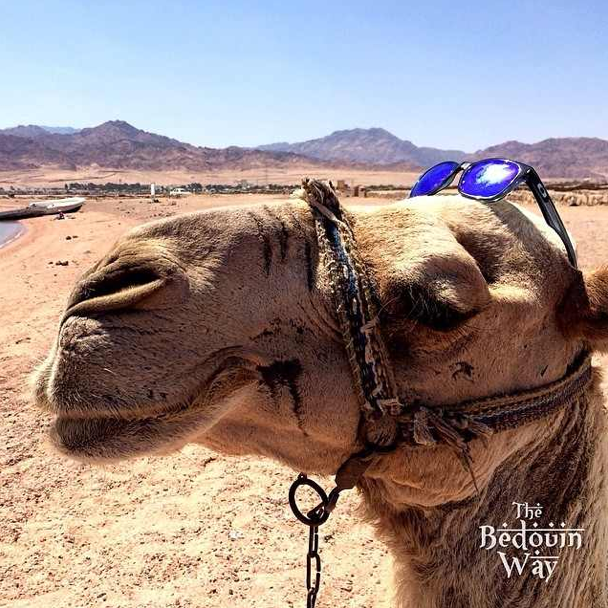Camels are an important part of our life and culture and each has its own very different personality. We call them the Gift of God (“Ata Allah”) because they provide so much of what we need in life - transport, milk, food and clothing. Arab poets also call them the 'ship of the desert” or “land ship” as they have the perfect bodies for life in the desert*.
Here at The Bedouin Way we want you to learn a little more about these beautiful, loveable, funny-looking creatures that mean so much to us and fascinate you. We talked to Ramadan Soleman, Atik Salaam and Gomaa Farag, so this has been written in their words. We hope you enjoy our story from Sinai!
A member of the family
The older Bedouin generations respect camels very much because they were so important in life before the days when we had cars. We treat our camels like our children. We love them, feed them, talk to them and they are family to us. They like quiet places so we try to help them be relaxed and happy away from noise. Some families have two camels, and others have 30 or 40 for tourism. Each has its own personality, just like people.
Caring for each other
If they are sick we treat them with herbs. There are some special people in Dahab who can also give heat treatment to draw out the sickness, which is very effective. Eleyan Faraj and Mohamed Abu Soradic (both from Assalah) are known for this.
Camels can also help us when we are sick. Their milk is very healthy for the body, and if we have arthritis we wear a bracelet made from camel hair and rabbit bones, which helps the pain. The camel can feel if a person is sick. If you are not well the camel becomes more gentle and he will try to take you back home.
They also know if you are scared. Once Atik Salaam was on a trip with a guest in the Wadi Gnai Oasis. He says, “My customer left me alone and slept away from me in the desert. I was scared as I was by myself and I had nowhere to sleep so I lay next to my camel. The camel knew I was scared and didn't move all night. He made me feel safe. The camel takes care and looks after you because you're his man.”
Pregnancy, perfume, and practice
Female camels are pregnant for 12 months. They have one baby each pregnancy and sometimes 10 or more children in their lifetime. The baby leaves her after three years when it is old enough to look after itself.
You should never wear skin cream, perfume or anything with a strong smell when you are with a baby camel or it will die. This is why we take the mother to the desert to have her baby – it is silent there and safe away from people. She is taken there for her last month of pregnancy to have the baby and then she comes back after one month. The best camel milk comes when the mother is weaning.
We train camels when they are three years old with a rope and we show them how to move with us. Then at four years they learn to carry things. We use special people to teach them. You must control the camel and be strong – there is a system to follow to have a well-behaved animal. The male always remembers what he is taught for life, but the female will forget after one year so if she is not reminded we need to train her again. Racing camels have different training because they have to learn to run fast with a person on their back.
Camels and companionship
The female is usually friendlier than the male, especially to her owner. They become friends and she will never leave him alone. If he dies she will stay with him and die herself if she can. There is a story that in Saudi Arabia an old man died in the desert, and his female camel was found dead next to him a long time after. She did not want to leave him there alone because she loved him.
But males also become very close to their owners. When Ramadan Soleman’s 74-year-old uncle died, his camel cried for one month all day and all night. Ramadan says, “He was a good man and treated the camel like his child. He had it for 15 years and he only fed it the best herbs and plants.”
Gomaa Farag had a camel for two years and he says, “The camel takes on your personality. I bought him when I was 15 years old but he was crazy. Over time he became more chilled out. If you are calm and relaxed with your camel then he will be the same. If you are nervous and angry he will take this on also. “
Gomaa also says that, “When you have a camel you never forget him because you have a nice time. Two camels become friends very much also - if they live together and one leaves, then the other is very upset.”
Crazy camel
In the winter the male camel will become crazy when he is on heat and you should never trust him, as he does not respect people. He will not eat or drink and he makes a song when he sees a female or another camel. He loses his mind and sometimes we have to put something in his mouth to keep it closed. There are many stories about males killing their owners when in this season. The way you will know is they make a “bubble mouth” to show they have the power – they control all other male camels this way and make them shut down.
Clever camel
All camels have a great memory. They know the voice of their owner from a very long distance. They always know their way home and remember where there is a water place in the desert. Once you show them this they will always go back to it when thirsty.
Every tribe has a brand on its camels. They are sometimes in the desert for a long time but everyone knows they belong to. During Spring Pasture time, we leave the camel to eat for as long as it wants to and it will go to its home when it is ready and there are no more things to eat.
According to very old Bedouin stories, 1 May to 5 June every year is when men, women and animals all over the world have less energy. Old people tell their children and grandchildren that they would not even let their camels work during this time. This is because you cannot see the stars (nejoom) so the mood is not always good. This time is called “gyub al nagem”.
Camel cuisine
As well as transport, milk and clothes we eat camel meat. There are special camels just for food – they are eaten when they are young and big. The best age for this is six years old. A professional person will kill them in the halal way – the camel dies calmly, and the person who slaughters it will say, "Bismillah Allahu akbar” to make sure the animal has Allah’s blessing. The common translation is "In the name of God, most Gracious, most Compassionate".
Halal means foods that Muslims are allowed to eat under Islamic Shariʻah. We try to eat animals that have had a happy life, nice food to eat, space to move and a peaceful death.
*Useful Facts
On the move
Camels have feet for all kinds of land. When the animals sit down on hot sand, they have hard skin on their knees, which protects them from burning and they can swim naturally because they have long legs. Camels can run at a speed of 65 km/h (18 m/s; 40 mph) in short runs and they can stay at 40 km/h (11 m/s; 25 mph) for one hour. They can carry 200kg weight and they are very strong. This makes them useful when we have to move or for safaris.
Eating and drinking
The hump of the camel carries stores fat from food, and saves it for when food is not there. They can live for a week or more without water and several months without food, but we always feed and water them when we can. The first sign that a camel needs food is when the hump turns soft and does not stand up any more. Camels mostly eat grass, a’dra and sh’eer, which we grow especially to feed them. Their long necks help them to reach plants that are higher from the ground.
The mouth allows camels to eat the tough thorns that even sheep and goats cannot manage. This is possible because their lips have strong hair that lets them take their noses to thorny plants and break them. The mouth is specially made for chewing and digesting plants with thorns.
Fighting off sand and wind
Their hair is thick and protects against the extreme conditions of the desert, and it also helps to keep water in the body. They can close their nostrils to stop sand coming inside and their long eyelashes also protect them against wind and sand.
How old is an old camel?
They normally live for around 32 to 40 years.
Buying a camel
A normal camel costs between EGP 6,000 and 10,000 (EUR 625 - 1,040) . For racing, the price will change according to its dynasty (“salala”). We trace their family back as far as we can, so for example a 4x4 can be traced 4 generations back on each side of the family and a 5x5 can be tracked 5 generations back. In Sinai some are EGP 100,000 (EUR 10,400) and in the Emirates they can cost more than EGP 1 million (EUR 104,000).
If you have any other questions about camels please ask us here and we will be happy to answer them.
Copyright © 2014, The Bedouin Way. All rights reserved.







